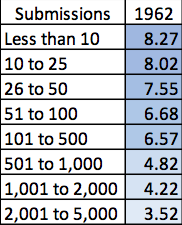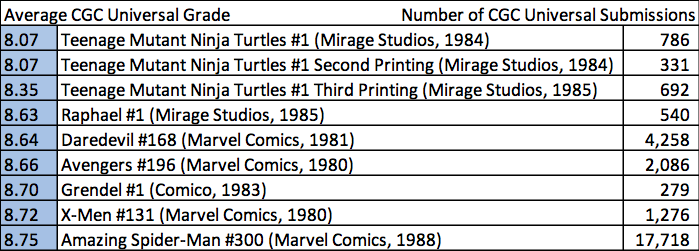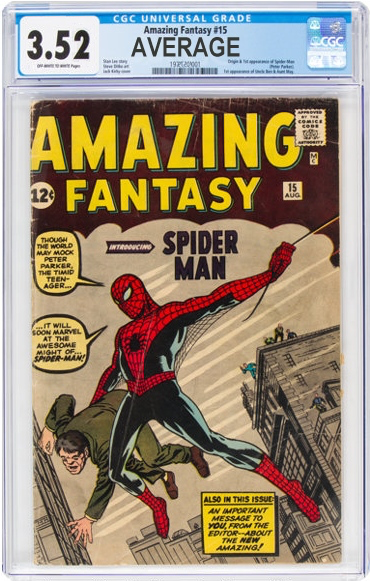How far do CGC average grades drop as comics get older?
The CGC Census reflects which comic books and how many copies of each have been submitted to CGC for grading and encapsulation for over 20 years. There are 204,534 individual comics with 5,210,195 copies CGC graded according to the June 30, 2020, CGC Census. With very few exceptions, newly-released comic books have always been sold without any certification or encapsulation, and billions of comic books printed through the decades still exist as those same “raw” comics in personal collections and dealer inventories. It is tempting to use the CGC Census as a view into the existing quantities and surviving conditions of comic books, but it is important to understand what the CGC Census can and cannot reveal. Statistics are easy to calculate with the CGC Census but may be harder to interpret or to apply to the comic book industry as a whole.

The average CGC universal grade is 8.74 on the 10-point scale for 4,267,080 universal comic books. Another 829,255 comics have been signed in front of a CGC witness for the CGC Signature Series and have an average condition of 9.29. More than 110,000 other comic books were submitted with amateur or professional restoration, an unwitnessed cover signature, or a flaw that qualified the grade as non-universal.
With an average CGC universal grade of 8.74, it would be tempting (but not accurate) to say that the majority of comic books in existence are probably about 8.74 condition. However, the CGC Census does not provide a random sampling of all comic books in existence, and the average CGC universal grade is only specific to the CGC Census data. In order for any comic book to be included in the CGC Census and these calculations, it must be CGC graded.
While any comic book can be CGC graded, most are not. Comic books must be deemed “worthy” of CGC grading and submitted to CGC accompanied by the costs of grading. The question of whether a particular comic book is “worthy” of CGC grading is inherently connected to whether the comic is “worth” CGC grading. CGC grading (as opposed to keeping the comic “raw”) includes the cost of shipping the comic book to and from a CGC facility and the cost of the grading service itself.
It makes little financial sense for a comic book valued at $5 to be CGC graded at a cost of $35 (for example, including grading service and shipping to/return charges, total costs vary by comic type and shipping distance) unless the comic book is in a condition high enough to sell for more than $40 after CGC grading. While it is true that a portion of CGC graded comics are submitted due to more sentimental value than the cost of grading, or submitted with no plans for selling, the majority of CGC graded comics were submitted to certify the condition (as unrestored or for restoration quality) for comic books in which the secondary market value of the graded comic was expected to justify the cost of CGC grading.
As a result of these common selection criteria for which comic books are submitted to CGC and which comic books are not, the CGC Census does not reflect a random sampling of all comic books in existence. Very few copies of comic books with low individual value have been CGC graded and those were most likely selected for their higher conditions than the average ungraded copy.
Some assumptions can be tested with the CGC Census data. It is assumed that older comic books have a lower average condition than more recent comic books, having more time since their original publication to accumulate defects. Many older comic books were printed on cheaper paper materials with the expectation of being primarily disposable publications and may have had little protection for decades when compared to bagged and boarded comic books today. Although the CGC Census does not represent a random sampling of all comic books in existence, the CGC Census should still be useful for determining whether older comic books are – on average – in lower condition than newer comics.
The average CGC universal grades by decade of publication for comic books are:

Each average CGC grade shown is for universal (blue label) CGC grades. A color shading has been applied to indicate higher grades in darker blue and lower grades in lighter blue.

The CGC Census confirms that the age of a comic does generally reflect the average universal condition for those comics which have been submitted to CGC, but there is not a perfect correlation between the age of the comic books and the average CGC grade.
For example, in the decade of the 1960s, the average CGC universal grades by year are:

The years of 1962 and 1963 do not fit the pattern expected for the average CGC universal grade and the age of the comic, since they are more recent than comic books from 1960 and 1961 but have lower average CGC universal grades. The average CGC universal grade is at least partially dependent upon the age of the comic book, but there is clearly another factor in average universal grade reflected by the CGC Census.
Because the value of comic books is a significant part of the selection criteria commonly used when choosing books for submission to CGC, comic books from the same year would not be expected to have the same average CGC universal grades when the number of submissions varies. More valuable comic books are submitted more often, since they are deemed “worthy” of CGC grading in lower conditions.
For the year of 1962, the average CGC universal grades by number of universal submissions are:
The average CGC universal grade for comic books from 1962 is 5.97, but 1962 comic books submitted less than 25 times average over 8.0, while the average CGC universal grade for the most valuable 1962 comic book is 3.52 for Amazing Fantasy #15 (AF #15). AF #15 is the only 1962 comic book currently submitted more than 2,000 times in universal condition. The lower average CGC universal grade is due to the higher value of even low grade copies of AF #15. All conditions of AF #15 are “worth” CGC gradingand surviving copies of AF #15 are better represented in the CGC Census than the surviving copies of other 1962 comic books.
 |
It is possible that the average conditions of all comic books from 1962 are closer to 3.52 than the average CGC universal grade of 5.97 for 1962. Other valuable 1962 comic books, such as early issues of Fantastic Four and Incredible Hulk have been submitted between 1,001 and 2,000 times. The average CGC universal grade for 1962 books submitted 1,001 to 2,000 times is 4.22, approaching the 3.52 average of AF #15 with more than 2,000 submissions. If all conditions of all comic books from 1962 were “worth” CGC grading, we should expect the CGC Census for 1962 to look more like the 3.52 average for AF #15, below the 5.97 average for 1962. Expanding the average CGC universal grades by number of submissions for the 1960s: |

These results for the decade of the 1960s provide a two-dimensional view of average CGC universal grade, where the age of the comic is combined with the number of CGC universal submissions, and the lowest average CGC universal grades occur when the comic is both older and submitted more often.
The highest average CGC universal grade is not necessarily for those comics submitted less than 10 times. Comic books submitted fewer than 10 times after 20 years of CGC operations generally have very low individual values, even in high grade. Those submissions may represent sentimental value or a desire to complete a set, rather than any potential for financial incentive in the secondary market. Comic books submitted fewer than 10 times from 1966 to 1969 reflect a lower average CGC universal grade than books submitted from 10 to 25 times for 1966 to 1969, and lower than books submitted 26 to 50 times for 1969, but the decrease in average CGC universal grade is consistent across all 1960s years as the number of submissions increases from 10 to 100 to 1,000, etc.
Looking elsewhere, the results for the 1980s are similar to those of the 1960s, with higher average grades across the board for the 1980s due to the recency of the issues and the increase in the use of comic book protective bags and boards in the 1980s when compared to the 1960s.
The average CGC universal grades by number of submissions for the 1980s:

Comic books from the 1980s with less than 10 submissions have a lower average CGC universal grade for all years than the comic books with 10 to 25 submissions, but also lower than books with 26 to 50 submissions, 51 to 100 submissions, and 101 to 500 submissions. The earlier assumption that 1960s books are submitted fewer than 10 times due to lower individual values is even more applicable to books from the 1980s which may still be found at very low prices more than 30 years later, even under $1 each. Any financial incentive to have $1 comic books graded by CGC would need to be significant to balance against the cost of CGC grading, which is at least $20 per book, even after discounts, once the cost of shipping to and from a CGC facility is included. There are more than 10,000 different comic books from the 1980s submitted to CGC fewer than 10 times after 20 years of CGC operations. Most of these 10,000 different comics have low values even in high grades and represent titles with a much lower demand than mainstream titles, and they may also be international editions or reprint editions when representing mainstream titles.
The most submitted comic book to CGC is Amazing Spider-Man #300 (ASM #300) from 1988, with more than 17,700 universal submissions to CGC, and more than 22,000 overall submissions. The average CGC universal grade of 8.75 for the grouping of “More than 10,000” in 1988 is attributed to just the one book, Amazing Spider-Man #300, and it is the lowest average for all groups in the decade, though there are a few individual comic books from the 1980s with a lower average CGC universal grade than 8.75.
The list below represents all 1980s comic books with a lower average CGC universal grade than ASM #300 with at least 1% of the ASM #300 total number of universal submissions (minimum of 178 universal CGC submissions):

In this list, there are four comic books from Mirage Studios, which were printed in a larger-sized format than standard 1980s comic books and may have been harder to protect the condition as a result. Three additional Marvel comic books are included, which are 7 or 8 years older than ASM #300. Perhaps the additional age is balanced against the significant difference in the number of universal submissions, resulting in all four Marvel books having nearly identical average CGC universal grades. The one outlier is Grendel #1 (Comico, 1983), which is closer in age to ASM #300 than the other Marvel comics with fewer universal submissions than any other book on the list.
It is not possible to know how many copies of each comic book have survived, however, comic books which are the same age and approximately the same values with similar average CGC universal grades may have been submitted at similar rates (percent of surviving copies) through the 20 years of CGC operations. The number of copies printed for Grendel #1 is likely far lower than any of the Marvel issues, but it is possible that the same percentage of the surviving copies may be represented on the CGC Census by the three Marvel comics, Grendel #1, and Raphael #1, having such similar average CGC universal grades, particularly if their secondary market values are similar. Future analysis of the CGC Census combined with GPAnalysis.com (GPA) recorded sales for CGC graded comics will explore the individual value as an important factor in both the number of CGC submissions and the average grade.
Combining comic book ages and number of submissions, using the blue color-shading to indicate lower (lighter) or higher (darker) average CGC universal grade, the CGC Census has these results:

Conclusion
The CGC Census reflects the selection criteria of the people submitting comic books to CGC for over 20 years, combining the age of each comic book and the number of submissions, resulting in a calculatable average CGC universal grade. The lack of a financial incentive for CGC grading of most mid-grade and lower condition comic books assures that the CGC Census primarily represents the upper conditions identified among existing copies of a comic book, not a random sample. For those few comic books which are valuable enough to submit to CGC in any condition, the CGC Census reflects a much lower average CGC universal grade.
While CGC 9.8 is the most common grade, more than one-third of all CGC graded comics are CGC 9.8 universal or CGC 9.8 signature series, the average “raw” comic book in existence is far below a 9.8 average condition. When comic books are better represented on the CGC Census (that is, when more copies are submitted), the average comic book is not even close to 9.8. There are 1,165 different comic books which have been graded at least 500 times, and the average CGC universal grade is 8.47.
Even the 8.47 average is not representative of all surviving copies, only representing those books selected for submission to CGC. The average comic book is significantly below the CGC average grades, and many first-time submitters to CGC are disappointed by their results. They should take solace in the fact that they are not alone. A few comic books are giving us a better idea of what may exist beyond CGC, since they are worth grading in all conditions, and the next analysis in this series will build upon what can be understood about the comic book market and surviving copies with information from books like Amazing Fantasy #15 and its average CGC universal grade of 3.52.

About the Author
 |
Greg Holland has collected comic books for over 30 years and has been the administrator of the CGC Census Analysis website since 2003, currently located at CGCdata.com. He is the 1999 founder of the ValiantComics.com website and the 2004 ValiantFans.com message board. Dr. Holland holds a Ph.D. in information quality from the University of Arkansas at Little Rock and has held data science positions as research director, analyst, and administrator for government, corporations, and university. Active on the CGC Forums as ‘valiantman’ since 2002, he is also a 15+ year advisor to the Overstreet Comic Book Price Guide and contributor to later editions of the Standard Catalog of Comic Books. Greg resides in Arkansas, USA, with his wife of 23 years and their daughter. |
Related news
24 Oct 2022
Canadian Price Variants (CPVs) and GPAnalysis.com Recorded Sales
With Canadian Price Variants recorded in GPAnalysis.com for decades, what can the data tell us about rarity and value when comparing against direct editions?
Read more26 May 2022
CGC Census - A Game for the Thousandth Collector
Imagine a game where 1,000 lucky comic collectors are awarded the best available copies of comic books from the CGC Census. Where would ticket #1,000 be for the earliest appearances of favorite characters? Some winning books may surprise you.
Read more